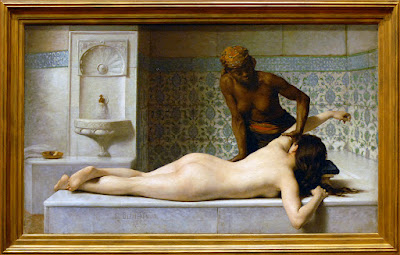前言
處理痠痛,你用對方法了嗎?這篇文章將為大家回顧西方醫學研究文獻,試圖在目前常用的治療方式中,比較出更適合解決痠痛的選擇。以下分三部分探討常用的治療方式:(1) 穿貼輔助、(2) 物理治療、(3) 活動方式。在最後的結論中,我將整理出確實有效果的方法。
大綱
穿貼輔助
在運動場上,你可能會看到許多運動選手身上貼著一條條五顏六色的貼帶,這些貼帶原名肌內效貼布 (kinesiology tape),在台灣的授權商品名為肌能系貼布 (kinesio tape),如圖一所示,以下簡稱為肌貼。

肌貼是 1980 年代由日本 Kenzo Kase 醫生所發明,近年來風靡世界體壇,在國際賽事的電視轉播中,各國選手身上都能見到它的蹤影。這個流行引起了運動醫學界的好奇,在最近三年開始陸續有肌貼療效的研究發表。研究的方式是讓實驗組貼上肌貼,對照組沒有貼肌貼,比較兩組人在運動後的生理狀況是否有差異。結果自 2014 年到最新 2017 年,不同研究團隊的實驗結果皆指出使用肌貼並未帶來幫助 [1-7]。實驗指出,使用肌貼不會讓肩膀力量更大、不會讓你跳得更高、對腿部肌肉與踝部平衡都沒有幫助。最重要的,使用肌貼對於痠痛的發生與恢復都沒有幫助。
雖然有三篇研究論文表示肌貼有療效 [8-10],但是這三篇論文的研究方法都缺乏對照組,所以無法證明到底是受測者休息三天自然恢復,還是肌貼對受測者有幫助。我們從這三篇論文的作者可以看到,都是來自韓國的相同作者,然後連續三年都投稿在影響指數 (impact factor) 只有 0.271 的同一個冷門期刊上。大家這時候請自行判斷,是要相信韓國作者有瑕疵的研究宣稱肌貼有效,還是相信多國各自研究都顯示肌貼無效。
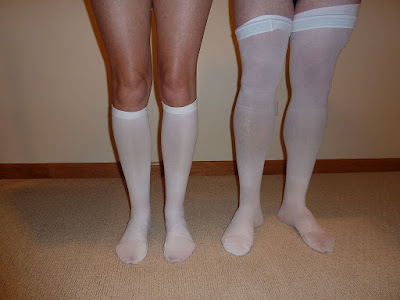
肌貼針對部分肌肉給予收縮壓力輔助,相對地,壓縮絲襪 (compression stockings) 則是對整個腿部肌肉給予收縮壓力輔助,如圖二所示。壓縮絲襪宣稱能幫助血液循環、預防靜脈曲張,以及減輕腿部痠痛 [11]。科學家因此找了馬拉松選手來做實驗,驗證壓縮絲襪是否能減少肌肉損傷與痠痛 [12]。研究結果顯示,壓縮絲襪不能減少肌肉損傷與痠痛。
這個章節我們討論了肌貼與壓縮絲襪,文獻顯示這兩樣產品都對痠痛的預防與治療沒有幫助。至於消炎止痛藥的痠痛貼布,在我先前的文章中已探討過(運動保健:讓痠痛恢復得更快,請停用消炎止痛藥 — 它們抑制了蛋白質合成),它只有短時間的止痛效果,不能幫助解決痠痛,甚至會讓痠痛拖延更久。所以作為解決痠痛的方法,目前常用的穿貼輔助可能都只有心理安慰效果,或短時間地藥物止痛,並沒有實際預防或解決痠痛的功效。
物理治療
這個章節將討論物理治療常用的方法對於痠痛的療效,包含超音波震動、電療、高壓氧氣、牽引治療、冷浴、以及熱療。
超音波震動療法起於 1940 年代,圖三展試了現代桌上型與手持式治療用超音波設備。電療的歷史則可追溯至 1767 年,透過圖四畫家的手繪,展示了百年前的電療情境。超音波震動與電療的發展歷史悠久,早已成為台灣物理治療院所的醫療標準設備。這些設備甚至被推銷至運動中心與家庭,讓運動員或一般人在有需要時可以隨時使用。然而,醫治疾病不等於解決痠痛,因此我們必須檢視超音波震動與電療是否能有效解決痠痛。研究結果顯示,超音波震動療法無助於解決痠痛 [13-15],電療也無助於解決痠痛 [16-17]。雖然韓國有一則研究宣稱超音波震動能治療痠痛 [18];但是該研究過程使用超音波震動直到第三天後才開始呈現較明顯的差異,因此不能確認痠痛降低是人體三天自癒力的成果還是超音波的療效。
高壓氧氣與牽引機是醫療用的配備。高壓氧治療透過增加血液含氧量,達到治病的功效;牽引治療透過拉伸骨椎降低神經壓迫,達到治病的效果。然而,醫治疾病不等於解決痠痛。近期的研究結果顯示高壓氧治療無助於緩解酸痛 [19],甚至在 48~72 小時內增加疼痛感 [20];牽引治療亦無助於解決痠痛 [21]。這個結果顯示,當我們因為痠痛跑去做牽引,完成六次一個療程後覺得痠痛比較緩解,可能是人體的自癒力發揮作用,並非這些醫療配備的幫助。
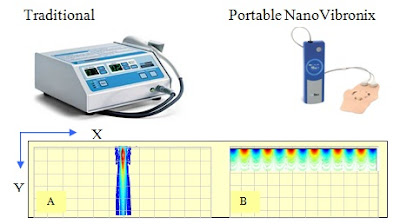
接著談到冷浴與熱療。冷浴可能是使用 10 度以下的冰水浴或者是 10~24 度的冷水浴來降低體溫,熱療則是使用紅外線或熱敷墊來升高體溫。關於冰水浴,在我先前的文章(解決痠痛問題,採取熱敷較有效,冰敷反而會延誤組織修復)已詳細討論過,冰敷無助於解決痠痛,熱敷才有效。冷水浴是一般水療 (Spa) 的溫度範圍,許多人在運動後喜歡泡入冷水池內 Spa 放鬆一下。只是,研究結果指出,冷水浴只有安慰的效果 [22],對解決痠痛或恢復運動表現都沒有幫助 [23-25],甚至會減弱組織的氧合反應 [26]。因此,熱療是相較於冷浴較佳的選擇,也被證實有療效 [27]。只是,這還不足以說服我們完全接受熱療。因為 2013 年 <<臨床醫學研究>> 期刊比較了乾式熱療與濕式熱療的效果,結果顯示兩者都對痠痛有療效,而濕式熱療的效果又更好 [28]。以白話來說,就是乾乾的紅外線或熱敷墊,療效不如用濕濕的熱毛巾或直接泡熱水澡。
這個章節我們討論了物理治療中常用的幾種療法。研究指出,超音波震動、電療、高壓氧氣、牽引治療、冷浴都無助於療癒酸痛。並且熱療雖然有效,但以濕的毛巾熱敷或泡熱水更有效。

活動療法
在這個章節我們將討論拉筋、瑜珈、適當的活動、以及按摩對酸痛的療效。首先是拉筋,研究顯示運動前熱身拉筋無助於預防運動傷害 [29],並且拉筋反而會降低運動表現 [30],所以現代運動指導建議以動態熱身取代靜態拉筋。再者,拉筋亦無助於預防或減少酸痛 [31]。本體感覺神經肌肉誘發術 (Proprioceptive Neuromuscular Facilitation, PNF) 是由專業人員協助引導運動員拉筋,亦無助於減少酸痛 [32]。
有趣的是,瑜珈練習有助於減少酸痛、加速恢復疲勞 [33]。同樣是伸展運動,拉筋與瑜珈似乎得到的是相反的成效。欲解釋這個現象,我們先觀察圖五與圖六,比較拉筋與瑜珈對於肩膀肌肉的差異:
拉筋是肌肉被動地拉伸,肌肉處於放鬆休息狀態;
瑜珈是肌肉主動地延展,肌肉處於輕微活動狀態。
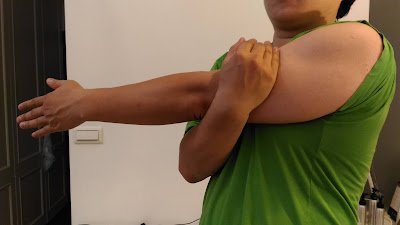
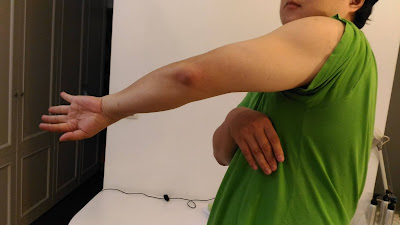
因為適當地運動比完全休息還更能解決痠痛 [34],所以瑜珈式的伸展有助於解決痠痛便得到理論上的支持。對於需要保持身體柔軟度的運動員,練習瑜珈式伸展或許是優於傳統拉筋伸展的選擇。
在所有解決痠痛的方法當中,按摩已被證實能加速療癒痠痛、恢復疲勞。早在 20 年前,運動醫學的指標期刊便已做過系統性的研究,確認按摩對於運動痠痛的療效 [35]。直到最近的 20 年間,按摩的療效持續被世界各地的研究單位證實 [36-42]。在生理研究方面,證實按摩能促進消除乳酸 [43]、提升免疫力 [44]。在運動項目方面,證實按摩能幫助療癒來自重量訓練的痠痛 [45],以及療癒來自跑步的痠痛 [46-49]。更積極地,按摩能夠提升運動員素質、增進運動表現 [50-52]。
這個章節我們討論了幾種活動身體的方式。研究指出,拉筋與本體感覺神經肌肉誘發術都無助於解決痠痛,傳統的方法 — 瑜珈、適量運動、按摩 — 確實都能解決痠痛。
結論
我們已經回顧了穿貼輔助、物理治療、以及活動方式對於解決痠痛的效果。在眾多方法當中,有效果的是:
- 熱療,特別是濕的熱療 (例如,泡熱水)
- 適當地運動
- 瑜珈式肌肉伸展
- 按摩
很湊巧地,這四個方法都可在東方醫學的經典術科中找到對應項目,依序是:藥浴、導引、武術功操、按摩。有了東方醫學與西方醫學的共同支持,大家從此不必再走冤枉路、花冤枉錢,用這四個方法幫助自己就對了。泡熱水、緩和運動、練功、按摩,雖然都不是醫療院所的服務項目,但卻是被證實對痠痛有療效的方法。
醫生與醫事人員的專長在於醫治疾病,讓醫治疾病歸醫療專業,解決痠痛請找按摩專業。希望這篇文章能幫助大家,在各種解決痠痛的方法中,選擇最適合自己的方法。
即時獲取本站最新消息與 Dr. 李侑青交流互動,請按讚追蹤粉絲頁喔 ➝
參考文獻
首圖是法國畫家 Edouard Bernard Debat-Ponsan 在 1883 年的畫作 ,作品呈現的是一位富有的阿拉伯女子正在接受黑人女僕的按摩服務。這幅畫現在存放在 musée des Augustins 博物館。
[34] G. C. Bogdanis, “Effects of Physical Activity and Inactivity on Muscle Fatigue,” Frontiers in Physiology, vol. 3, no. 142, 2012.
[35] E. Ernst, “Does post-exercise massage treatment reduce delayed onset muscle soreness? A systematic review,” British Journal of Sports Medicine, vol. 32, no. 3, pp. 212-214, 1998.
[36] P. Khamwong et al., “Prophylactic Effects of Sauna on Delayed-Onset Muscle Soreness of the Wrist Extensors,” Asian Journal of Sports Medicine, vol. 6, no. 2, pp. e25549, 2015.
[37] J. H. Han et al., “Effects of therapeutic massage on gait and pain after delayed onset muscle soreness,” Journal of Exercise Rehabilitation, vol. 10, no. 2, pp. 136-140, 2014.
[38] N. Nelson, “Delayed onset muscle soreness: is massage effective?” Journal of Bodywork and Movement Therapies, vol. 17, no. 4, pp. 475-482, 2013.
[39] T. M. Best et al., “Effectiveness of sports massage for recovery of skeletal muscle from strenuous exercise,” Clinical Journal of Sport Medicine, vol. 18, no. 5, pp. 446-460, 2008.
[40] L. A. Frey Law et al., “Massage reduces pain perception and hyperalgesia in experimental muscle pain: a randomized, controlled trial,” The Journal of Pain, vol. 9, no. 8, pp. 714-721, 2008.
[41] J. Brummitt, “The Role of Massage in Sports Performance and Rehabilitation: Current Evidence and Future Direction,” North American Journal of Sports Physical Therapy, vol. 3, no. 1, pp. 7-21, 2008.
[42] Z. Zainuddin et al., “Effects of massage on delayed-onset muscle soreness, swelling, and recovery of muscle function,” Journal of Athletic Training, vol. 40, no. 3, pp. 174-180, 2005.
